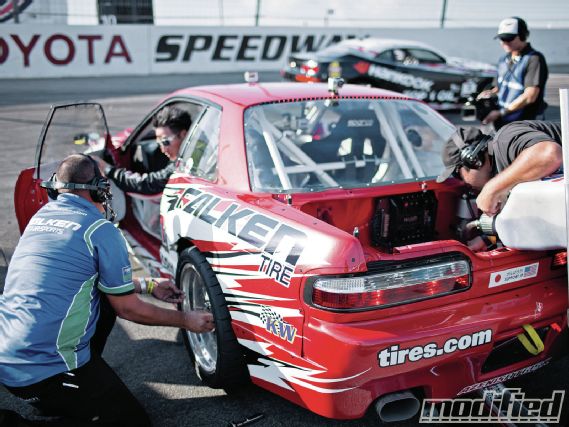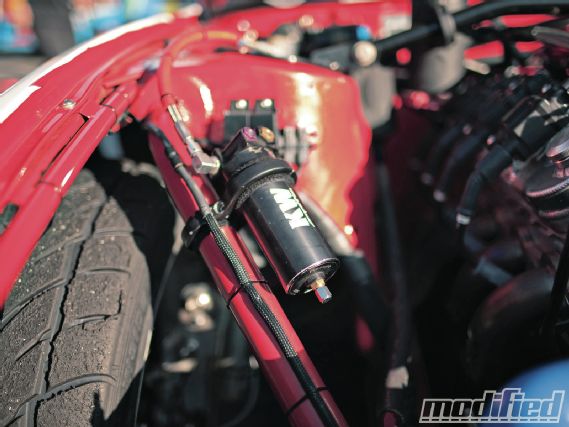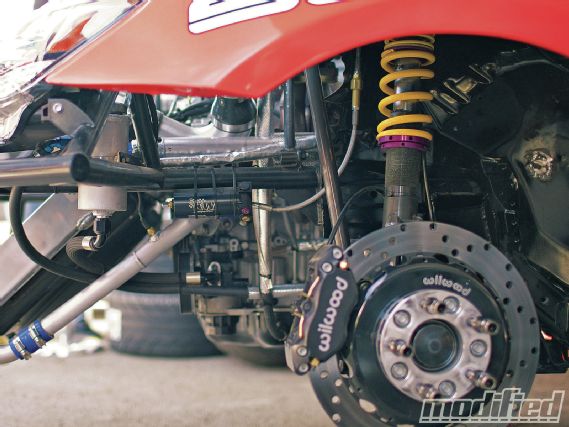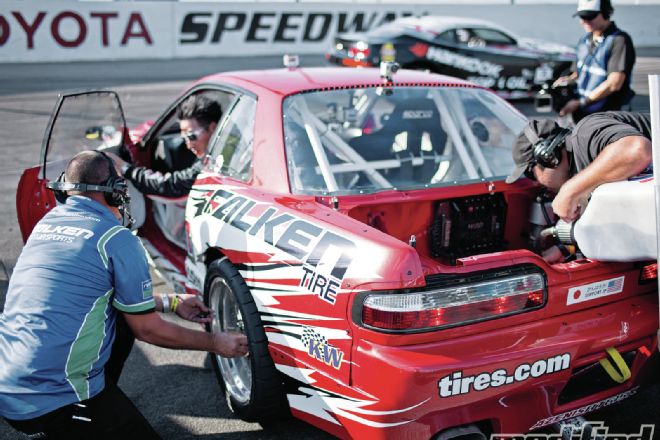 | Basic Drift Chassis Setup - Tech
| Basic Drift Chassis Setup - Tech
My normal drifting job is setting up the chassis to make Dai Yoshihara’s Discount Tire/Falken Tire S13 do its thing on the Formula D circuit. For the pros there are a lot of tricks and engineering going into making those cars go sideways, changing directions and maneuvering with lighting-fast precision. Quite possibly the fastest growing motorsport, drifting is getting more and more popular on the grassroots level. Although your local drift day can sometimes attract hundreds of enthusiastic beginning drifters, the scene is mostly lacking even a basic knowledge of how to properly set up a car for drifting.
We do some extreme high-dollar secret tricks on the pro cars, but the grassroots drifter can get 80 percent of the way there by getting the basics right. Proper setup will make the car easier to handle in drift and speed up your learning curve. Unlike most grassroots motorsports, many people in the drift scene are seemingly oblivious on how to make their cars work better, being more concerned with things like stance than a properly functioning setup. For those who care, we decided to write down some basic low-cost guidelines on what it takes to set up your car for drifting.
A grassroots drift car will have a setup that’s somewhat different to the high-powered, high-grip cars that are prevalent in pro drifting events like Formula D or even the semi-pro Formula D feeder Pro-Am series. The main difference is that grassroots drifters have much less power and don’t have an endless supply of high-grip tires to burn through. We’ll put an emphasis on a low-cost, easy-to-drive setup that’s well balanced so it will be simple to learn different drifting techniques. Surprisingly, a good drift setup is much like a grip driving setup used in track days or even autocross: you want to have a balanced car that has little understeer, good turn-in and not an excessive about of oversteer. Let’s get started.
Suspension
A good set of coilovers is a very wise investment — they’re the heart of what will make your drift car handle well. It can be a stretch for your budget, but if you can’t afford a good basic set of coilovers, then try to save your money to get some; TEIN, A’PEXi and KW are good coilovers for a lot of popular drift cars. If you’re an advanced drifter, some of the best basic coilovers for the money are KW Clubsports. Their double-adjustable damping gives enough flexibility to see you all the way up to pro competition.
Be wary of the cheap Chinese coilovers. Some of these may be decent, but many are really bad, and there are so many fly-by-night brands that it’s hard to keep track of which ones are especially bad. Remember that cheap Chinese coilovers often have adjustment knobs that do little to actually vary the damping, and some are actually only there for looks! Don’t skimp — buy the best coilovers you can afford.
Race car stiff is out — for drifting, you want to use spring rates that are only a little stiffer than typical high-performance street coilover spring rates.
For spring rate, you want to choose something that will give pretty good balance while not being too stiff. Race car stiff is out — for drifting, you want to use spring rates that are only a little stiffer than typical high-performance street coilover spring rates. For the super-popular 240SX, something like an 8kg front and a 6kg rear are good. For other cars, you might want to use what people are doing for track days with street-based cars. Typically, you want a wheel rate — or spring rate at the wheels — slightly stiffer in the front than the rear. This is important because many cars, especially multilink ones, have different motion ratios that put different leverage rates on the springs.
To determine what your wheel rate is, you can jack your wheel up through the stroke after removing the springs and measure how far your wheel travels over its stroke. Then measure how much your shock moves over the wheel’s stroke; after that, divide the amount your shock moves by the amount the wheel moves. The resulting number is your motion ratio, which you can multiply by your spring rate to get your approximate wheel rate.
 | Basic Drift Chassis Setup - Tech
| Basic Drift Chassis Setup - Tech
When adjusting your coilovers, don’t commit the cardinal sin of suspension setup: lowering your car too much. Some lowering is good, but too much is bad. Even though it may look hellaflush, the suspension isn’t designed to work at those angles and results in poor performance. Generally, you don’t want to lower the car more than 2 inches — anything more than that, and you start to screw up the suspension geometry. You also want to make sure you have plenty of wheel travel; we like to have 2.5–3 inches of bump travel and 1.5–2 inches of droop (certainly no less than 1 inch of droop). You want to avoid having the car bottom out while under drift, as that will drastically change the car’s balance and usually result in spinning out or understeering badly.
When adjusting your damping, avoid the common mistake of making your shocks too stiff. Too stiff, and the car will hop and bounce in drift, making it hard to control even though it might feel responsive to steering; too little damping, and the car will feel floaty and unresponsive like a boat. Correct adjustment will have a decent ride but firm control. Don’t be afraid to tinker and experiment to find the right setup for your car. You can also use the shocks’ adjustment to control how the car starts to drift and how it feels. Soft rear shock adjustments will usually make the rear of the car grip up and have more forward bite, although it can also make the car want to straighten up and be twitchy in drift; stiffer in the rear can make the car looser and easier to get into drift. Stiffer damping in the front makes the car turn-in sharper with more response — softer slows it down.
Sway Bars
A lot of people in the drift world discount the importance of sway bars. Sway bars make a car feel much more stable in drift and allow big changes to be made in how easily the car can be set in drift and how much angle the car will run in drift. It’s best to get a matched set of bars that are adjustable. Whiteline and Progress make adjustable bars for many popular cars. If an adjustable bar isn’t available for your car, you can make your bars adjustable by having a fabricator weld a plate with adjusting holes on the end of your bars using universal spherical endlinks (like what Whiteline sells).
When you’re practicing, it’s much easier to adjust your sway bars to change your car’s balance compared to changing springs. Typically, you want to run a set of bars that’s about 20 to 50 percent stiffer in the front than the rear; adjustments typically make a 10 to 30 percent difference in overall roll stiffness, so you can really change the car’s feel through bar adjustments. With most reasonably sized bars, about 30 to 60 percent of the total overall roll resistance also comes from the bars. This is one reason why drifting a car with sway bars is so much easier: the car responds faster and is more predictable.
When setting up your bars, be sure that they don’t bind or contact the chassis because the suspension strokes through its travel.
When setting up your bars, be sure that they don’t bind or contact the chassis because the suspension strokes through its travel. This sort of stuff can make the handling very unpredictable. Sometimes people remove the front antisway bar because it interferes with steering angle — the front tires hit it when turned full lock. In this case, it’s better to extend the lower control arm so they won’t hit anymore. It’s not good to stack a bunch of front wheel spacers to do this because it hurts the scrub radius (and opens another set of problems).
Bushings
Although replacing your bushings with harder ones isn’t absolutely necessary, they don’t cost a lot and will keep your alignment consistent under hard loading. They can also help reduce wheelhop that can break drivetrain parts. You can get replacement bushings for most cars from many sources like Energy Suspension; harder or solid bushings are particularly useful in the Nissan S-chassis subframe, as they can shift as much as half an inch under load.
 | Basic Drift Chassis Setup - Tech
| Basic Drift Chassis Setup - Tech
Alignment
Alignment is one of the most important things in getting your drift car to handle correctly, and it’s a subject that’s mangled quite a bit on Internet forums. It’s important to make your alignment adjustable. In the case of you having a popular car like a Nissan S-chassis, you can get adjustable front tension rods, rear toe, traction and camber links — all off-the-shelf — from companies like SPL Parts and Battle Version. If you have a car with MacPherson struts in the front, you can often get camber plates. Ground Control Suspension has camber plates for many different cars.
One way to make the camber adjustable on MacPherson strut cars cheaply is to drill out one of the spindle bolts slightly. Then you can tilt the spindle inward while tightening up the bolts. Surprisingly, this won’t slip as long as you tighten the stock bolts fully. This can get you a couple of degrees of adjustment. Once you make your car adjustable, you can try these basic alignment settings. Remember, these are drift settings and aren’t necessarily good for everyday street driving. Rapid tire wear on the street may occur. However, you’ll probably get better tire wear when drifting!
Front-wheel Camber
Go with 3 to 4 degrees of negative camber, which helps put the tread flat on the ground when under side load. Under load, the tire’s carcass wants to flex and lift the inside of the tread off the ground; as the car rolls, it also wants to tip the tire to where the inside of the tread is being lifted off the ground. The car’s suspension geometry tries to make up for some of this, but it can’t totally compensate — running negative camber compensates for this. By keeping the tread on the ground, you get better front grip and less understeer. You don’t want your drift car to understeer if you can help it. If your car has multilink front suspension, you can use closer to 3 degrees of negative camber; a strut-type suspension can use closer to 4 degrees.
When you start to drift, you can simply let go of the wheel and let if feed through your fingers, and the car will counter faster than if you were steering it yourself.
Front Toe
You want to run a slight amount of toe out, typically about 1/8-inch total; this will help your car initiate better by turning in sharper. This makes a big difference when you’re trying to feint. Too much toe out makes the car twitchy, so I don’t recommend more than ¼-inch toe out.
Caster
You want to run as much positive caster as you can get without hitting the fenders. This is typically around 7 degrees or so on most cars. Caster really helps a drift car by making it self-steer better. When you start to drift, you can simply let go of the wheel and let if feed through your fingers, and the car will counter faster than if you were steering it yourself. Caster also gives you more negative camber as the wheel turns, which helps front grip. More caster helps the car turn in better and also makes the car more stable.
Offset
Don’t run very low wheel offsets to look hellaflush; it increases the scrub radius too much and hampers steering precision and can cause understeer and poor turn-in when done to the extreme. Don’t go crazy with lip and wheel spacers.
Rear-wheel Camber
On a drift car, you want to run the rear camber as close to zero as possible. This will usually give you the best tire wear and best forward bite. If you want a little more side grip, you can run some negative camber, but usually no more than 1 degree negative should be run. Don’t believe the negative camber hype — run little to no camber and you’ll be a better drifter.
 Basic Drift Chassis Setup - Tech
Basic Drift Chassis Setup - Tech
Rear Toe
This is a subject that has a lot of misconceptions, as many people try to tune how the car is balanced in drift by adjusting the rear toe. You shouldn’t run too much rear toe-in on a drift car. By doing so, you’ll have a car that will straighten up if the throttle is lifted or modulated. This is the leading cause of serious drift car crashes. A car’s understeer/oversteer balance should always be adjusted in the suspension, not by using the toe. If you want the car looser, with more oversteer, increase the rear bar stiffness and/or rear spring rate and stiffen the rear shock. If you want to tighten up the car, with less oversteer, run softer rear bar, spring and shock.
Run a little toe in — usually, you want to run about 1/8-inch. Cars with semi-trailing arm rear suspensions like BMW E30s, Nissan Z31s and S12s can run more like ¼-inch toe in, as these cars will toe out under roll. If you’re having trouble making angle in high-speed turns, run zero rear toe, but never run rear toe out — that will make your car very twitchy.
Increased Steering Angle Mods
A lot of people also modify the steering for more angle. This gives you more countersteer and helps prevent you from spinning out. Typically, this involves putting a spacer between the inner tie rod joint and the steering rack; it’s an OK thing to do, but be aware it also might increase bumpsteer slightly.
S-chassis guys have options: you can purchase excellent knuckles on the market — we like the Hariguchi S-chassis knuckle because it gives a lot more angle while preserving the critical steering geometry. If you modify your knuckle, be aware about increasing bumpsteer and do your best to keep the steering pickup points on the same plane as stock.
Tire Pressure
Tire pressure has a huge effect on how a drift car handles. For neutral balance, if you’ve generally followed our guidelines, you want to run near or close to 32 psi hot all around — this is your stable temperature after a few runs. You want to start with your cold temps a few psi below this and will probably have to bleed pressure after every run. Once you get some experience, you’ll more or less know about what cold pressure to start with.
The best tire pressure will vary, depending on the car, the type of tire, the rim width and a bunch of other factors, but this will be a good starting point. If you have a low-powered car with a stock engine, you can pump up your rear tire pressures as high as 50 psi to help keep the car sideways. If you rock a big-turbo car or a V-8, you can run as low as the low 20s to help with forward bite, although super-low tires pressure are best left to the pros, as it can make the car twitchier and the tire could debead with a sudden loss of tire pressure.
These are the basics of drift car chassis setup — do this right and you’ll be ahead of the game. When you move up to Pro-Am, are starting to do some serious tandem drifting or are getting into the pro levels, there are many other tricks that can be put to use, but they’re quite a bit more technical. We’ll cover these later.
Remember to have fun, don’t be afraid to experiment to find what is best for you and don’t practice on the street!

